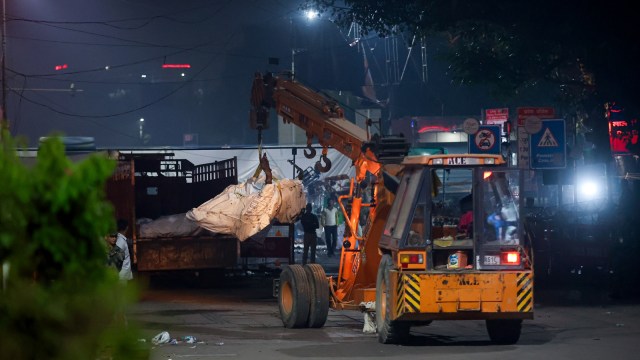Red Fort blast: AIIMS to test DNA of Pulwama suspect’s parents — why it’s key to the case
Matching the DNA with the unidentified bodies at Lok Nayak Hospital can confirm if the suspect died in the explosion or remains at large.
 Debris being removed a day after an explosion ripped through a car near the Red Fort on Tuesday. (Express photo by Praveen Khanna)
Debris being removed a day after an explosion ripped through a car near the Red Fort on Tuesday. (Express photo by Praveen Khanna)The DNA sample of the mother of Dr Umar Nabi Bhat, the prime suspect in the Red Fort blast case, has been collected and sent to the AIIMS Forensic Laboratory in the national capital for further analysis, official sources said.
According to sources, DNA samples from his father have also been collected in Pulwama, Jammu and Kashmir. These samples will be matched with unidentified bodies kept at Lok Nayak Hospital in Delhi, which were brought in on the night of the blast.
According to police sources, Umar is suspected to be the man driving the Hyundai i20 that exploded near the Red Fort on Monday evening — killing nine people — and the person captured on CCTV footage sitting inside the car.
Umar, a resident of Koil village in Pulwama, has been missing since the blast. He was employed at Al Falah University’s School of Medical Sciences and Research Centre in Faridabad.
Investigators rely on DNA profiling in blast cases to identify suspects or victims when bodies are mutilated or unrecognisable. In this case, matching the DNA of Umar’s mother with the unidentified bodies at Lok Nayak Hospital could confirm whether the suspect died in the explosion or remains at large.
Why are a mother’s DNA samples a crucial piece of evidence?
According to Delhi-based forensic experts, in the aftermath of explosions, fires, or mass disasters where victims are severely burned or unrecognisable, DNA testing has become the most reliable tool for identification.
A biological mother’s DNA often plays a crucial role in confirming the identity of victims through advanced genetic analysis.
When traditional methods such as fingerprinting or facial recognition are not possible, forensic scientists turn to the most preserved parts of the body — typically bones or teeth — to extract DNA. These hard tissues protect genetic material better than soft tissue, even under extreme heat.
Identification is made possible through kinship analysis, a process that compares the victim’s DNA with that of biological relatives. A mother’s DNA, obtained through a simple cheek swab or blood sample, provides a direct and reliable genetic reference.
What methods are used in DNA identification?
Two primary methods are employed in this process.
The first is autosomal STR profiling, which examines short tandem repeats in nuclear DNA. Since a child inherits half of their DNA from each parent, matching 50% of these markers with the mother’s sample can confirm identity with high accuracy.
When nuclear DNA is too damaged, scientists rely on mitochondrial DNA (mtDNA) analysis. As mtDNA is inherited exclusively from the mother and exists in large numbers within each cell, it often survives extreme conditions that destroy other genetic material. Although it can only confirm maternal lineage, mtDNA analysis remains a vital tool when other methods fail.
Sources said this technology is not yet available on a large scale in India, and AIIMS primarily uses it for research purposes.







